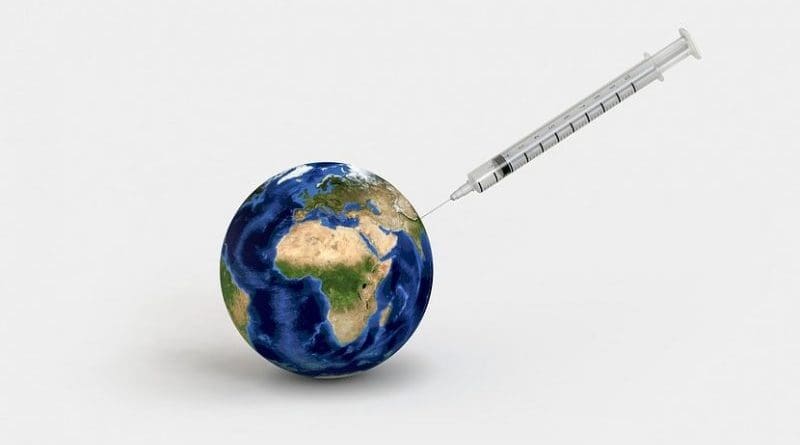Rich Countries Still Need To Step Up On Global COVID Vaccine Access – Analysis
By Ken Heydon*
Among the G20 goals being pursued by the Indonesian chair this year is ‘ensuring equitable access to COVID-19 vaccines’. This has become a pressing task, though one that’s part of a bigger picture. Developing country vulnerability means global vulnerability. The Delta variant, first detected in India in April 2021 before becoming a world crisis, illustrates the danger of having large pockets of unvaccinated people.
There is both an ethical and a self-interested reason for helping poorer countries cope with COVID-19.
Between mid-2020 and the end of 2021, 10 billion COVID-19 vaccine doses were produced and there is now global capacity to produce 12 billion doses a year. But distribution has been highly uneven with less than 1 per cent of the vaccines going to low-income countries.
The World Health Organization’s (WHO) COVAX initiative has fallen well short of its target of delivering two billion doses to lower-middle and low-income countries by the end of 2021. Low-income countries have received barely 3 per cent of the US$650 billion in special drawing rights issued for the International Monetary Fund’s pandemic response.
The result — compounded by widespread vaccine hesitancy in poor countries — is a high discrepancy in vaccination rates across the world. Nigeria, for example, has vaccinated less than 2 per cent of its population, and nearer to Australia Papua New Guinea less than 3 per cent. Some 40 per cent of the world’s population is yet to receive a single shot of a COVID-19 vaccine.
Epidemiologists now warn that large swaths of the world may soon be inundated with new waves of COVID-19. Totally eliminating the virus seems to be a pipe dream — it simply has too many chances to multiply.
Two much discussed ways of helping developing countries are problematic and will not help in the short run. The first is the relaxation of intellectual property rights to facilitate the transfer of mRNA technology to developing countries, that, for the moment, neither Pfizer nor Moderna is willing to consider. Patents — guarding knowledge now to promulgate more in the future — remain a crucial incentive for needed research into emerging variants.
Pfizer and Moderna have agreed to the second course of action: building factories of their own within developing countries, with early moves in South Africa, Rwanda and Senegal. Johnson and Johnson and Oxford-AstraZeneca have also set up multiple manufacturing sites globally. International institutions are backing these private sector initiatives with, for example, the International Finance Corporation making significant investments in India, Senegal and South Africa.
In fostering developing country manufacturing capacity, Singapore has been identified as a possible role model. French pharmaceutical company Sanofi’s proposed production facility there offers a potential template in digital infrastructure and equipment capabilities that allow for quick changeovers, enabling toggle between three or four different types of vaccines.
But here is the rub — and the qualifier to this second course of action. Singapore is hardly representative of developing countries that, for the most part, have neither the trained people nor the regulatory regime needed to establish and maintain a safe and reliable vaccine manufacturing capacity. Some developing countries also impede their own manufacturing potential by imposing tariffs on critical vaccine inputs. In short, new factories will not come online fast enough to meet demand.
The immediate need is for increased dedicated production and export from advanced economies (and developing countries, like India, with the necessary capacity) to developing countries of variant-adapted vaccines — whether mRNA, viral vector or recombinant protein vaccines. This will need to be backed by financial transfers to the poorest countries to enable them to import vaccines.
Increased vaccine supply to poorer countries, though essential, is not sufficient. It needs to be accompanied by improved vaccine advocacy, and, critically, by wider curative treatment in developing countries, like Pfizer’s antiviral pill, because, realistically, many of the poorest countries will not be able to maintain a full repeat vaccination program. A necessary complement to increased vaccine availability in poorer countries is the establishment of reliable drug distribution channels making treatment cheap, widely available and free of counterfeits.
Even better developing country access to both vaccines and treatment will not guarantee that the virus will be denied opportunities to multiply. Effectively dealing with COVID-19 also calls for greater vaccine mobility in the rich world, especially the United States where only 64 per cent of the population is fully vaccinated, and in China where reliance on relatively inefficient inactivated vaccines has left many people still insufficiently protected against serious illness.
All this serves to highlight the importance — and difficulty — of Indonesia’s task as G20 chair in 2022 of ensuring equitable access to COVID-19 vaccines. It also highlights the need for a holistic approach based on multilateral cooperation on what is likely to be a continuing global challenge.
*About the author: Ken Heydon is a Visiting Fellow at the London School of Economics and Political Science. He is a former Australian trade official and senior member of the OECD secretariat.
Source: This article was published by East Asia Forum

